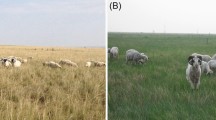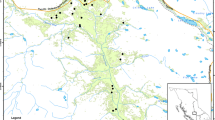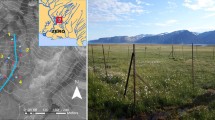Summary
Research was conducted to determine the effects of a native, sedentary rodent of North American grasslands, the black-tailed prairie dog (Cynomys ludovicianus), on seasonal aboveground plant biomass and nutrient dynamics and plant species diversity. The study was done on a northern mixed-grass prairie site at wind Cave National Park, South Dakota.
Peak live plant biomass was greatest (190 g/m2) on the uncolonized part of the study area and least (95 g/m2) on a part of the prairie dog town colonized for 3 to 8 y. Peak live plant biomass (170 g/m2) of the oldest portion of the prairie dog town (colonized >26 y) was not significantly different from that of uncolonized prairie. However, where-as graminoids composed >85% of the total biomass of the latter area, forbs and dwarf shrubs (Artemisia frigida) were >95% of the total of the former. Both standing-dead plant biomass and litter declined markedly as time since colonization increased. Total plant species diversity (H) was greatest in the young prairie dog town (colonized for 3 to 8 y).
Nitrogen concentration of plant shoots varied significantly as a function of time since colonization. Shoot-nitrogen was lowest in plants from the uncolonized site and greatest in plants collected from the longest-colonized areas of the prairie dog town. Shoot-nitrogen declined significantly over the growing season and tended to be higher in C3 graminoids than in C4 graminoids. In vitro digestible dry matter showed similar trends; the differences between C3 and C4 digestibilities were greatest during the last half of the growing season.
We suggest that prairie dog-induced changes in plant biomass, plant species diversity, plant nutrient content, and forage digestibility may lead to further alterations of nutrient cycling and trophic dynamics in this mixed-grass prairie ecosystem.
Similar content being viewed by others
References
Akin DE, Burdick D (1977) Rumen microbial degradation of starch-containing bundle sheath cells in warm-season grasses. Crop Sci 17:529–533
AOAC (1965) Official methods of analysis, 10th ed. Association of Official Agricultural Chemists, Washington D.C. 957 pp
Archer S, Detling JK (in prep). The effects of defoliation and competition on regrowth of two North American mixed-grass prairie graminoids
Bement RE (1969) A stocking-rate guide for beef production on blue-grama range. J Range Manage 22:83–86
Bonham CD, Hannan JS (1978) Blue grama and buffalograss patterns in and near a prairie dog town. J Range Manage 31:63–65
Bonham CD, Lerwick A (1976) Vegetation changes induced by prairie dogs on shortgrass range. J Range Manage 29:221–225
Brown RH (1978) A difference in N use efficiency in C3 and C4 plants and its implications in adaptation and evolution. Crop Sci 18:93–98
Bruggen T Van (1976) The vascular plants of South Dakota. The Iowa State Univ Press, Ames. 538 pp
Burzlaff DF (1971) Seasonal variations of the in vitro dry matter digestibility of three sandhill grasses. J Range Manage 24:60–63
Caswell H, Reed F, Stephenson SN, Werner PA (1973) Photosynthetic pathways and selective herbivory: a hypothesis. Am Natur 107:465–480
Chew RM (1974) Consumers as regulators of ecosystems: an alternative to energetics. Ohio J Sci 74:359–370
Cole JE (1958) Ten-year summary prairie dog report: Wind Cave National Park. Typewritten memorandum to the Park Superintendent. 18 pp. (WCNP files)
Coppock DL (1981) Impacts of black-tailed prairie dogs on vegetation in Wind Cave National Park. M.S. Thesis, Colorado State Univ., Fort Collins. 86 pp
Coppock DL, Detling JK, Dyer MI (1980) Interactions among bison, prairie dogs, and vegetation in Wind Cave National Park. Unpublished Final Report to the National Park Service, Wind Cave National Park, South Dakota. 195 pp
Coppock DL, Ellis JE, Detling JK, Dyer MI (1983) Plant-herbivore interactions in a North American mixed-grass prairie. II. Responses of bison to modification of vegetation by prairie dogs. Oecologia (Berl) 56:10–15
Costello DF (1970) The world of the prairie dog, J B Lippincott Co, Philadelphia and New York. 159 pp
Dalsted KJ, Sather-Blair S, Worcester BK, Klukas R (1981) Application of remote sensing to prairie dog management. J Range Manage 34:218–223
Daubenmire R (1959) A canopy-coverage method of vegetational analysis. Northwest Sci 33(1):43–64
Deinum B, Dirven JGP (1975) Climate, nitrogen and grass. 6. Comparison of yield and chemical composition of some temperate and tropical grass species grown at different temperatures. Neth J Agric Sci 23:69–82
Detling JK, Painter EL (submitted) Defoliation responses of western wheatgrass populations with diverse histories of prairie dog grazing. Oecologia (Berl)
Dodd JL, Lauenroth WK, Heitschmidt RK (in press) Effects of controlled SO2 exposure on net primary production and plant biomass dynamics. J Range Manage
Dyer MI, Detling JK, Coleman DC, Hilbert DW (1982) The role of herbivores in grasslands. In: Estes JR, Tyrl RJ, Brinken JN (eds) Grasses and Grasslands: Systematics and Ecology, p 255–295
Everson AC (1966) Effects of frequent clipping at different stubble heights on western wheatgrass (Agropyron smithii, Rydb.). Agron J 58:33–35
Hansen RM, Gold IK (1977) Blacktail prairie dogs, desert cottontails and cattle trophic relations on shortgrass range. J Range Manage 30(3):210–213
Harper JL (1969) The role of predation in vegetational diversity. In: Diversity and Stability in Ecological Systems. Brookhaven Symposium in Biology 22:48–62
Jameson DA (1964) Effect of defoliation on forage plant physiology. In: Forage Plant Physiology and Soil Range Relationships ASA Spec Publ No 5, p 67–80
Kamstra LD (1973) Seasonal changes in quality of some important range grasses. J Range Manage 26(4):289–291
Kamstra LD, Schentzel DL, Lewis JK, Elderkin RL (1968) Maturity studies with western wheatgrass. J Range Manage 21:235–239
Kilcher MR (1981) Plant development, stage of maturity and nutrient composition. J Range Manage 34:363–364
Klatt LE, Hein D (1978) Vegetative differences among active and abandoned towns of black-tailed prairie dogs (Cynomys ludovicianus). J Range Manage 31(4):315–317
Kleinbaum DG, Kupper LL (1978) Applied regression analysis and other multivariable methods. Duxbury Press, North Scituate, Mass. 556 pp
Koford Carl B (1958) Prairie dogs, whitefaces, and blue grama. Wildl Monogr No 3. 78 pp
Lauenroth WK, Whitman WC (1977) Dynamics of dry matter production in a mixed-grass prairie in western North Dakota. Oecologia (Berl) 27:339–351
Lechleitner RR (1969) Wild mammals of Colorado. Pruett Publ Co, Boulder, Colorado. 254 pp
Lovaas AL, Bromley PT (1972) Preliminary studies of pronghorn antelope — black-tail prairie dog relations in Wind Cave National Park. In: Proc Fifth Biennial Pronghorn Antelope States Workshop, p 115–156
MacArthur RH (1972) Geographical ecology. Harper & Row, New York. 269 pp
McNaughton SJ (1976) Serengeti migratory wildebeest: Facilitation of energy flow by grazing. Science 191:92–94
McNaughton SJ (1979) Grassland-herbivore dynamics. In: Sinclair ARE, Norton-Griffiths M (eds) Serengeti, Dynamics of an Ecosystem. Univ Chicago Press, Chicago, pp 46–81
Milchunas DG, Baker DL (1982) In vitro digestion: Sources of within- and between-trial variability. J Range Manage 35:199–203
Milchunas DG, Dyer MI, Wallmo OC, Johnson DE (1978) In-vivo/in-vitro relationships of Colorado mule deer forages. Special Report No 43, Colorado Division of Wildlife
Minson DJ, McLeod MN (1970) The digestibility of temperate and tropical grasses. Proc. 11th International Grassland Congress (Surfers Paradise) 719–732
Morisita M (1959) Measuring of interspecific association and similarity between communities. Memoirs of the faculty of science, Kyushu Univ, Series E (Biology) 3:65–80
Mueggler WF (1972) Influence of competition on the response of bluebunch wheatgrass to clipping. J Range Manage 25:88–92
Mueggler WF (1975) Rate and pattern of vigor recovery in Idaho fescue and bluebunch wheatgrass. J Range Manage 28:198–204
Ode DJ, Tieszen LL, Lerman JC (1980) The seasonal contribution of C3 and C4 plant species to primary production in a mixed prairie. Ecology 61:1304–1311
Osborn B, Allan PF (1949) Vegetation of an abandoned prairie-dog town in tall grass prairie. Ecology 30:322–332
Owen DF, Wiegert RG (1976) Do consumers maximize plant fitness?. Oikos 27:488–492
Parton WJ, Ellis JE, Swift DM (1979) The impacts of strip-mine reclamation practices: A simulation study. In: Wali MK (ed) Ecology and Coal Resource Development, Vol II. Pergamon Press, New York, pp 584–591
Pearson HA (1970) Digestibility trials: in vitro techniques. In: Range and Wildlife Habitat Evaluation — a Research Symposium. US Dep Agric Misc Publ No 1147, p 85–92
Peden DG, Van Dyne GM, Rice RW, Hansen RM (1974) The trophic ecology of Bison bison L. on shortgrass plains. J Appl Ecol 11:489–498
Peterson RA (1962) Factors affecting resistance to heavy grazing in needle-and-thread grass. J Range Manage 15(4):183–189
Pielou EC (1977) Mathematical ecology. John Wiley & Sons, New York. 385 pp
Popp JK (1981) Range ecology of bison on mixed grass prairie at Wind Cave National Park. M.S. Thesis, Iowa State University, Ames. 59 pp
Redmann RE (1975) Production ecology of grassland plant communities in western North Dakota. Ecol Monogr 45:83–106
Schwartz CC, Ellis JE (1981) Feeding ecology and niche separation in some native and domestic ungulates on the shortgrass prairie. J Appl Ecol 18:343–353
Sims PL, Singh JS, Lauenroth WK (1978) The structure and function of ten western North American grasslands: I. Abiotic and vegetational characteristics. J Ecol 66:251–285
Snedecor GW, Cochran WG (1967) Statistical methods, Sixth ed. Iowa State Univ. Press, Ames. 593 pp
Summers CA, Linder RL (1978) Food habits of black-tailed prairie dog in western South Dakota. J Range Manage 31:134–136
Tilley JMA, Terry RA (1963) A two stage technique for the in vitro digestion of forage crops. J Brit Grassl Soc 18:104–111
Trlica MJ (1977) Distribution and utilization of carbohydrate reserves in range plants. In: Sosebee RE (ed) Rangeland Plant Physiology. Range Science Series No 4 Society for Range Management, Denver, Colorado, pp 73–96
United States Soil conservation Service (1969) Conservation plan for Wind Cave National Park, South Dakota. US Dep Agric. 46 pp. (WCNP files)
Wallace JD, Free JC, Denham AH (1972) Seasonal changes in herbage and cattle diets on sandhill grassland. J Range Manage 25(2):100–104
Waser NM, Price MV (1981) Effects of grazing on diversity of annual plants in the Sonoran Desert. Oecologia (Berl) 50:407–411
White LM (1973) Carbohydrate reserves of grasses: A review. J Range Manage 26:13–18
Wolda H (1981) Similarity indices, sample size and diversity. Oecologia (Berl) 50:296–302
Author information
Authors and Affiliations
Rights and permissions
About this article
Cite this article
Coppock, D.L., Detling, J.K., Ellis, J.E. et al. Plant-herbivore interactions in a North American mixed-grass prairie. Oecologia 56, 1–9 (1983). https://doi.org/10.1007/BF00378210
Received:
Issue Date:
DOI: https://doi.org/10.1007/BF00378210




